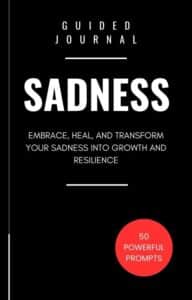In the depths of our souls, sadness resides as an unwelcome guest. It creeps in quietly, like a shadowy figure in the night, casting its gloom upon our hearts. We all experience moments of sadness, for it is an intrinsic part of the human experience. But what if we could harness the power of sadness and transform it into something beautiful? What if we could use the depths of our emotions as a catalyst for self-discovery and personal growth? This is where the art of journaling comes into play.
Journaling, in its rawest form, is an act of bearing witness to our emotions, thoughts, and experiences. It is an intimate conversation we have with ourselves, a sanctuary where we can pour out our hearts and minds without judgment. And in our moments of sadness, journaling becomes an indispensable tool for navigating the labyrinth of our emotions.
In this article, we will delve into the world of deep and profound journal writing prompts specifically tailored for sadness. These prompts are not meant to dismiss or diminish your pain, but rather to encourage introspection and self-reflection. They are the keys that unlock the doors to self-understanding and healing.
So, grab your favorite pen and your journal, and let us embark on a journey of self-discovery through the power of the written word. Let us dive deep into the recesses of our souls, armed with these 50 journal writing prompts for sadness, and emerge stronger, wiser, and more resilient than ever before.
Understanding Sadness: Exploring the Depths of Human Emotion
What is Sadness?
Sadness is a universal human emotion that we all experience at some point in our lives. It is a complex emotional state characterized by feelings of sorrow, unhappiness, and a general sense of melancholy. Sadness can arise from a variety of circumstances, such as loss, disappointment, loneliness, or even a deep longing for something or someone.
The Anatomy of Sadness
When sadness takes hold, it can manifest itself in various ways. Physically, it may be accompanied by tears, a heavy feeling in the chest, or a lump in the throat. Mentally, sadness can cloud our thoughts, making it difficult to concentrate or find joy in everyday activities. Emotionally, it often leads to a sense of vulnerability, sensitivity, and a decreased interest in things we once enjoyed.
The Purpose of Sadness
Contrary to popular belief, sadness serves an essential purpose in our lives. It acts as an emotional signal, indicating that something is amiss or that we have experienced a loss. Sadness allows us to process and come to terms with difficult events, aiding in the healing process. It serves as a reminder of our capacity to feel deeply and to empathize with others who may be going through similar struggles.
Examples and Relatability
Loss: The death of a loved one can trigger profound sadness. The absence of their presence, the memories shared, and the unfulfilled future plans can all contribute to an overwhelming sense of grief.
Rejection: Being rejected in a relationship or a job opportunity can lead to feelings of sadness. The disappointment and self-doubt that arise from rejection can have a profound impact on our emotional well-being.
Transition and Change: Moving away from home, starting a new chapter in life, or going through a significant life change can evoke feelings of sadness. The bittersweet nature of leaving behind what is familiar and stepping into the unknown can stir up a mix of emotions.
Longing: Sometimes, sadness can stem from a deep longing for someone or something that is out of reach. Whether it is yearning for a lost love, a missed opportunity, or a sense of belonging, this longing can leave us feeling melancholic and pensive.
Coping with Sadness
While sadness is an inevitable part of the human experience, there are healthy ways to cope with it:
Acknowledge and Accept: Recognize and accept your feelings of sadness. Allow yourself to experience and process the emotions without judgment.
Seek Support: Reach out to trusted friends, family, or professionals who can provide a listening ear and offer guidance during challenging times.
Practice Self-Care: Engage in activities that bring you comfort and solace, such as exercise, meditation, journaling, or pursuing hobbies that uplift your spirits.
Take Time to Heal: Give yourself permission to grieve and heal at your own pace. Allow the process to unfold naturally, and be patient with yourself.
The Transience of Sadness
One important aspect to remember is that sadness is transient. It may feel overwhelming in the moment, but like all emotions, it will eventually pass. By acknowledging and embracing our sadness, we can learn valuable lessons about ourselves, grow emotionally, and move forward with renewed strength and resilience.
Sadness is a profound and complex emotion that is an inherent part of the human experience. It can be triggered by various circumstances and serves a crucial purpose in our lives. By understanding and accepting our sadness, we can navigate through it with compassion, seek support when needed, and emerge stronger on the other side. Remember, you are not alone in your sadness, and there is light beyond the shadows.

The Transformative Power of Journaling: A Path to Healing Sadness
Are you feeling weighed down by sadness and searching for a way to navigate through the storm? Look no further than the power of journaling. This ancient practice of self-reflection has the potential to transform your emotional well-being and lead you towards healing and happiness.
In this chapter, we will explore the true essence of journaling, understand its benefits, and learn how to harness its power to overcome sadness.
Unveiling the Essence of Journaling
What is Journaling?
- Journaling is a personal writing practice where you express your thoughts, emotions, and experiences on paper or digitally.
- It provides a safe space for self-reflection, self-expression, and self-discovery.
The Transformative Power of Journaling
- Journaling allows you to gain clarity and perspective on your emotions and experiences.
- It helps you to identify patterns, triggers, and underlying causes of your sadness.
- Through journaling, you can release pent-up emotions and find solace and catharsis.
- It promotes self-compassion, self-awareness, and personal growth.
How Journaling Heals Sadness
Emotional Release
- Writing down your feelings can provide a release valve for pent-up emotions.
- By acknowledging and expressing your sadness, you allow yourself to process and let go of negative emotions.
Gaining Perspective
- Journaling allows you to step back and gain a fresh perspective on your sadness.
- As you write, you may uncover new insights, alternatives, or solutions to your challenges.
- Reflecting on past entries can also help you realize how far you’ve come and provide hope for the future.
Self-Exploration and Understanding
- Journaling encourages self-exploration and introspection, enabling you to understand the root causes of your sadness.
- By delving into your thoughts and emotions, you can identify patterns, triggers, and self-limiting beliefs.
- Understanding these underlying factors empowers you to make positive changes and break free from the cycle of sadness.
Gratitude and Positive Focus
- Incorporating gratitude journaling into your practice can shift your focus from sadness to gratitude and positivity.
- By consciously acknowledging and appreciating the blessings in your life, you cultivate a more optimistic mindset.
Practical Tips for Effective Journaling
Create a Safe Space
- Choose a quiet and comfortable environment where you can freely express yourself.
- Use a journal or digital platform that resonates with you and reflects your personal style.
Set a Regular Routine
- Dedicate specific times each day or week to journaling.
- Consistency is key to reaping the transformative benefits of this practice.
Embrace Authenticity and Honesty
- Be true to yourself and write honestly about your emotions and experiences.
- Avoid self-judgment or censorship; let your words flow freely.
Explore Different Journaling Techniques
- Experiment with different techniques such as free writing, prompts, gratitude journaling, or stream of consciousness.
- Find what resonates with you and adapt your journaling practice accordingly.
Now that you understand the true essence of journaling and its transformative benefits, it’s time to take action. Grab your pen and embark on this incredible journey of self-discovery, healing, and growth.
Remember, journaling is a personal sanctuary where you can pour out your heart, find solace, and emerge stronger than ever. Embrace the power of journaling, and let it guide you towards healing your sadness and creating a brighter future filled with joy and fulfillment.

Journal Writing Prompts for Sadness
Reflect on a time when you felt the deepest sadness. What led to this moment, and how have you grown since then?
Write about a movie or book that made you feel incredibly sad. Why did it affect you so profoundly?
Imagine sadness as a person. How would you describe them? What kind of relationship would you have with this person?
How do you express your sadness? Is it through tears, silence, or art? Explore why you express it this way.
Write a letter to your future self about a sad experience you’re going through right now. What advice or perspective would you like to offer?
Describe a place that evokes sadness within you. Why does it have this effect on you?
What is the hardest part about feeling sad for you? Is it the loneliness, the heaviness, or something else?
How do you perceive sadness in others? Are you empathetic, or do you find it difficult to relate?
If you could talk to your sadness, what would you say? Would you ask it questions, or express your feelings towards it?
Write about a time when someone else’s sadness deeply affected you. How did it change your perspective or behavior?
Explore the relationship between sadness and creativity. Do you believe sadness fuels creativity, or does it hinder it?
Delve into a memory that still brings you sadness. How has it shaped your current self?
What comfort or wisdom have you found in your moments of sadness?
Write a conversation between your happy self and your sad self. What would they discuss?
How do you believe society views sadness? Is it seen as a weakness, or is it accepted as a part of life?
Create a metaphor for your sadness. What does it look like, sound like, or feel like?
Write about a time when you tried to hide your sadness. Why did you feel the need to do so?
Explore a moment when you felt sad, but also grateful. How did these two emotions coexist?
Have you ever let sadness stop you from doing something? Reflect on this experience and how it has affected you.
Write about an experience where you felt sadness for the world. What caused these feelings?
Sadness and loneliness often go hand in hand. Describe a time when you felt both.
How has music played a role in your sadness? Is there a particular song that resonates with your feelings?
Write about a time when you found beauty in sadness. What made it beautiful?
Reflect on a moment when you used your sadness to help someone else.
How has sadness changed you as a person? Has it made you more compassionate, or has it hardened you?
Discuss a time when you felt misunderstood in your sadness. How did it make you feel?
Write a poem about your sadness. What emotions and imagery come to mind?
How do you take care of yourself when you’re feeling sad? What self-care practices work best for you?
Write about a time when you felt sadness and joy simultaneously. How did you navigate these conflicting emotions?
How does nature affect your sadness? Is there a particular landscape or weather that mirrors your feelings?
Explore a time when you felt sad for no apparent reason. How did you deal with these feelings?
What does acceptance of sadness look like to you? How can you practice it in your life?
Write a dialogue between you and an imaginary friend about your sadness. What would you want them to understand?
How has a significant loss in your life contributed to your understanding of sadness?
Write about a time when your sadness felt overwhelming. How did you cope with this intensity?
How does physical activity influence your sadness? Does it help alleviate it, or does it intensify it?
Write about a moment when a small act of kindness eased your sadness.
Explore the concept of sadness within your culture or religion. How is it perceived and dealt with?
Write a short story where the main character learns to embrace their sadness.
How does your sadness affect your sleep and dreams? Do you find comfort in dreams, or do they exacerbate your feelings?
Discuss a time when you felt guilty for being sad. Why did you feel this way?
Explore a time when your sadness led to a significant realization or change in your life.
Write about an object that symbolizes your sadness. Why does this object represent your feelings?
How does sadness affect your relationships? Does it bring you closer to others, or does it create distance?
Write about a time when you chose to be alone with your sadness. What insights did you gain from this solitude?
Reflect on a moment when your sadness felt like a heavy physical weight. How did it affect your day-to-day activities?
Discuss the role of sadness in personal growth. How does it contribute to your emotional maturity?
Write about a time when you weren’t allowed to express your sadness. How did it affect you?
How do you imagine life without sadness? Do you think it would be better or worse?
Write a letter to your sadness. What would you thank it for, and what would you ask it to change?
Download Printable Journal Prompts (PDF) >>
Guided Journal for Sadness
50 Profound Writing Prompts to Embrace, Heal, and Transform Your Sadness into Growth and Resilience

Are you tired of feeling stuck in the depths of sadness, longing for a way to navigate through your emotions and find healing? Do you yearn for a safe space to explore the profound depths of your sorrow and emerge stronger, wiser, and more resilient? Look no further than the Guided Journal for Sadness.
Sadness can be an overwhelming emotion, consuming our thoughts and leaving us feeling lost and disconnected. It’s all too easy to get trapped in a cycle of negativity, unable to find a way forward. Without proper guidance and support, our sadness can become a burden that weighs us down, hindering our personal growth and happiness.
Imagine waking up each day feeling the weight of sadness on your shoulders, unable to shake off the heaviness. Your mind is filled with a whirlwind of emotions, but you struggle to make sense of them. Loneliness and despair seem to be your constant companions, and hope feels distant and elusive.
You long for a way to process your sadness, to transform it into something meaningful and purposeful. You yearn for a tool that will help you navigate through the darkness, providing structure and guidance as you embark on a journey of emotional healing.
The Guided Journal for Sadness is your companion on this transformative journey. It offers 50 deep and profound journal writing prompts specifically designed to help you explore your emotions, gain insights, and find healing amidst your sadness.
With each prompt, you’ll delve into the depths of your soul, uncovering hidden truths and untapped resilience. You’ll be guided through a therapeutic process of self-reflection, self-compassion, and self-discovery, allowing you to gain a deeper understanding of your sadness and its underlying causes.
As you pour your heart onto the pages of this journal, you’ll find solace in expressing your emotions, validating your experiences, and embracing the healing power of self-expression. The guided prompts will gently coax you out of your comfort zone, encouraging you to confront your pain and transform it into growth.
Key Benefits:
Emotional Release: Explore your sadness in a safe and supportive environment, allowing yourself to release pent-up emotions and find catharsis.
Self-Reflection: Gain a deeper understanding of your emotions, thoughts, and experiences, enabling personal growth and self-awareness.
Healing and Resilience: Use the power of journaling to navigate through your sadness, transforming it into strength and resilience.
Guided Exploration: Benefit from expertly crafted writing prompts that encourage introspection, helping you uncover insights and find a path forward.
Empowerment: Take control of your emotional well-being by actively engaging in the healing process, empowering yourself to move beyond sadness.
Self-Compassion: Cultivate self-compassion and self-care as you embrace your emotions and practice kindness towards yourself during difficult times.
Don’t let sadness hold you back any longer. Embrace the power of journaling with the Guided Journal for Sadness, and embark on a transformative journey towards healing, growth, and resilience. Start today and discover the profound impact that self-reflection and self-expression can have on your emotional well-being.
As we come to the end of this exploration into the realm of deep and profound journal writing prompts for sadness, we realize that sadness, despite its heavy weight, can be transformed into a source of strength and resilience. Through the act of journaling, we have witnessed the power of self-reflection and introspection, and how it can guide us towards healing and personal growth.
Remember, dear reader, that sadness is not a sign of weakness, but rather a testament to your capacity to feel deeply. It is through embracing our sadness and allowing ourselves to sit with it, that we can truly understand ourselves on a profound level. And as we uncover the layers of our emotions, we find solace, wisdom, and a renewed sense of purpose.
So, the next time sadness knocks at your door, invite it in with open arms. Sit down with your journal, and let the words flow from your heart onto the pages. Embrace the power of self-expression and self-discovery, knowing that within the depths of your sadness lies the potential for profound growth.
As you continue on your journey of journaling and self-reflection, remember this: your words have the power to heal, to inspire, and to transform. Your journal is a sacred space, a sanctuary where you can truly be yourself. So, keep writing, keep exploring, and keep uncovering the hidden treasures within your soul.
And now, as you close this article and embark on your own personal journaling adventure, I leave you with a thought-provoking question: What lessons does your sadness hold for you?

